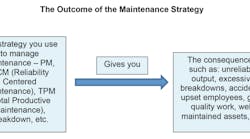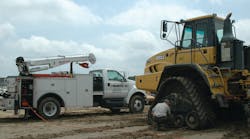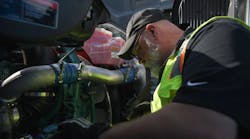Did you know that some breakdowns or component failures have tails? Of course, some failures don’t.
When a pebble hits your windshield and breaks it, that event does not have a tail.
A wheel bearing failure, on the other hand, has a tail and it is sometimes quite a long one. The origin of that breakdown is in somewhere in the past.
In the past, something happened to a component. Usually, it is some small bad thing like an overload, contamination or lubrication problem, and the tail leading to a failure starts.
DOOMED TO FAIL
Once the tail is established, the failure will occur. It is preordained.
This process is defined by a concept known as the P-F Curve. It is used to identify the point of failure and how early detection of a failure provides advance time to effectively plan and schedule the replacement of the component or the repair prior to failure.
The idea here is to focus on the tail.
If breakdowns have tails, we can do something about them. After all, an entire field called PM (preventive maintenance) was developed and designed to deal with those wayward failure tails.
TWO PARTS TO PM
In classes that I conduct, participants don’t always realize there are two parts to successful PM. Each of these parts is designed to address different- aged tails, and it is essential to see where the different parts of PM interact.
One big part of PM is affectionately called TLC (Tighten, Lubricate, Clean). This is basic, in- the- trenches, maintenance.
In the old days, it seemed like all technicians started TLC with a grease gun, rag and wrench. It is a great thing, too, because the root causes of most mechanical failures are directly traceable back to defects in TLC. What’s more, TLC impacts the tail just when it starts.
Remember the small bad thing – the contamination, lubrication problem or overload – mentioned previously? Well, TLC stops some of those bad things from turning into future failures.
Since TLC impacts the beginning of the tail, performing TLC will make a huge difference in the future, sometimes way in the future.
TAILS IN PROGRESS
TLC is half the PM discussion. It eliminates future bad events by preventing the tail from starting in the first place.
What do we do with tails already in progress?
We have a one-two punch for tails already started. The combination is preventive maintenance inspection (PMI) coupled with Corrective Maintenance (CM). PMI, which encompasses Predictive Maintenance (PDM), alerts us of the tail before the failure and CM corrects the defect that is the tail.
Now, we have tools for the short tails, PM in conjunction with CM, and for the long tails, we have TLC.
Any PM system that misses any aspect of TLC, PMI or CM will not address all of the tails in play. If your PM effort seems inadequate, look to these three processes for guidance.
ROI
People frequently complain that PM takes too long to provide a return on investment (ROI). In fact, TLC takes a very long time to show up on the company books.
PM Inspection and Corrective Maintenance, however, should show up pretty quickly in averted failures and avoided consequences.






